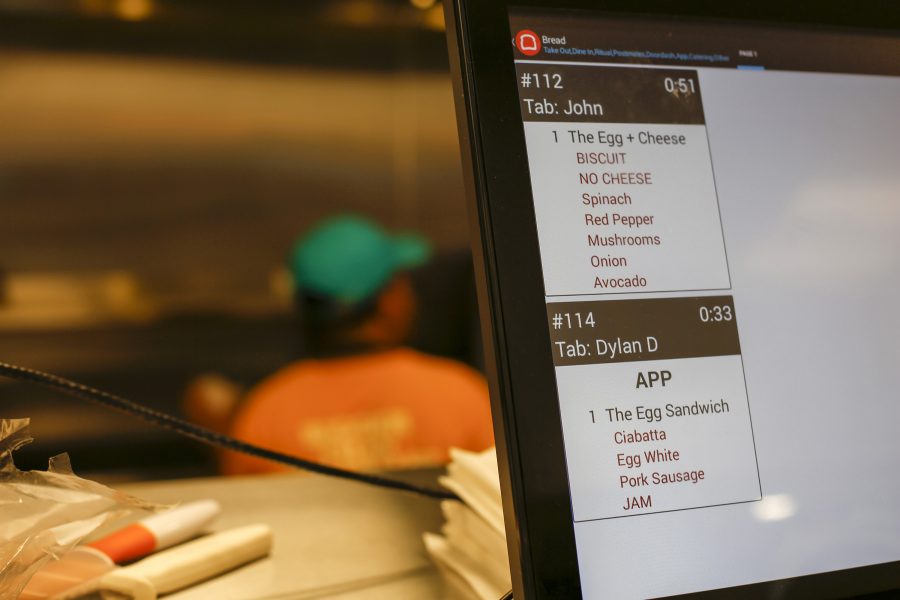Why restaurants want you to order food on your phone
An app order for Dylan Dowd is shown on the screen as he places his order via an app he used at Eastman Egg at Ogilvie Transportation Center on Sept. 12, 2016 in Chicago. Eastman’s app technology, called geo fencing, allows a customer to order at any time and their food is prepared only when the customer gets close to the restaurant. (Jose M. Osorio/Chicago Tribune/TNS)
September 29, 2016
By Samantha Bomkamp
CHICAGO — Swipe, click, food.
The ability to order food with the click of a few buttons on a smartphone is becoming widespread — even fast-food companies are getting in on the action. But the technology — which in some cases tracks a customer’s location and times food preparation accordingly — can vary widely. And restaurants admit that some customers are still wary about the freshness of their food when ordering ahead.
“I think some users assume (their food) would be sitting on that counter for them because that’s how most in the industry do it,” said Hunter Swartz, the founder and CEO of Chicago restaurant company Eastman Egg, who focused on a mobile app as a cornerstone of the firm’s development. “As much as we had to educate the public about our food, there’s been just as much education for the app.”
Mobile ordering is becoming a critical piece of many restaurants’ plans because of what it can bring in improved sales. Customers spend more and visit more often, on average, when they’re using a phone to order their food.
The first restaurants to make mobile a big part of their business were the ones that rely heavily on delivery: pizza makers. At Domino’s, you can order just by texting an emoji of pizza or opening their app; no clicking required. Pizza Hut and Papa John’s have made big advances, too, and all three credit about half their sales to mobile orders.
Few restaurants are as far along as the delivery operators, but many have advanced their own apps by leaps and bounds to capture more customers on the go.
Starbucks launched mobile pay through its app a year ago, and it now accounts for about 5 percent of sales, Chief Financial Officer Scott Maw said at a conference earlier this month. That jumps to 20 percent of transactions at peak times at several hundred of its urban stores. It expects that number to accelerate quickly in the near future, as customers get more comfortable with the technology. A quarter of Starbucks’ customer payments already are made with its smartphone app.
Maw also said Starbucks’ app eventually will be able to use weather data to market different food and drink items to customers, like a pumpkin spice latte on a chilly October day.
In June, Dunkin’ Donuts debuted mobile ordering nationwide and Chick-fil-A launched a new app with mobile ordering capabilities. Taco Bell has had mobile ordering capabilities on its app since 2014, but sister company KFC doesn’t offer it. McDonald’s, the world’s largest burger chain, has been testing its own mobile ordering system since the spring and has said that digital initiatives are a big priority in the near future.
Among fast-food restaurants, the frequency of customer visits increases by 6 percent and average spending per visit rises by about 20 percent when technology is used to place an order, according to a Deloitte survey released this month. Visits tend to increase because technology makes it easier to repeat an order automatically, while repeat orders of custom or upgraded drinks lead to increased sales.
In addition to an expected sales boost, the data collected from mobile ordering apps can shine light on the makeup of customers.
App capabilities are often vastly different from one to another.
“You’ve got a tremendous variability in terms of sophistication,” Deloitte restaurant analyst Andrew Feinberg said. “You’ve got Starbucks, Panera, Domino’s that are doing well, while you’ve got others that have been trying for a while and still struggling with it,” he said. “A lot of restaurants have a very long way to go.”
Starbucks’ mobile ordering system stores previous orders but it doesn’t allow customers to save a favorite store — a potentially frustrating missing link for a commuter who might pass several Starbucks stores on the way to work. Orders also can’t be placed in advance for a specific time. On the other end, Dunkin’ Donuts’ app lets customers order up to a day in advance and select a favorite store.
For restaurants developing mobile apps, there’s also another issue: customer overload. Despite dozens of major restaurant brands offering mobile ordering, customers only download an average of three restaurant apps to their phones, according to Deloitte. That’s increasing the pressure for those restaurants that haven’t implemented mobile ordering to do it quickly.
“There’s kind of a race for shelf space — except it’s a race for a share of customers’ minds — and phones,” Feinberg said.
———
©2016 Chicago Tribune
Visit the Chicago Tribune at www.chicagotribune.com
Distributed by Tribune Content Agency, LLC.








